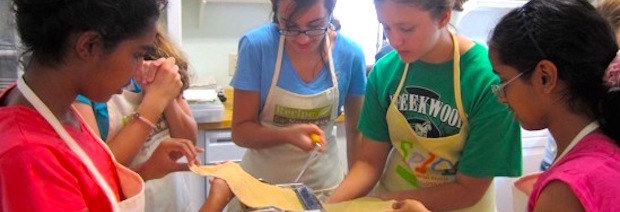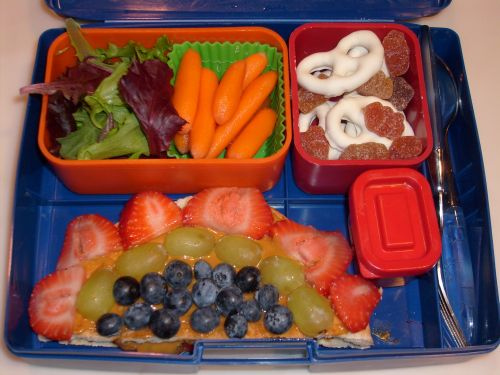 Ironic that fall hosts both National Childhood Obesity Month in September and National School Lunch Week in October. It was the sad state of school food that snared my attention nearly twenty years ago, eventually inspiring the launch of Recipe for Success.
Ironic that fall hosts both National Childhood Obesity Month in September and National School Lunch Week in October. It was the sad state of school food that snared my attention nearly twenty years ago, eventually inspiring the launch of Recipe for Success.
Our school hallways were filled with snack vending, and junk food concessions crowded the lunch line. These efforts to monetize poor eating choices among our youngest and most vulnerable were having a devastating effect. A deadly epidemic was spiraling out of control, (30% of American kids are obese.) Those in charge had perfectly plausible excuses: we are just giving the kids the food they prefer and therefore eat; the commissions and licensing fees are supporting our arts, our scoreboard, our music program; this is the best we can do on our limited budgets.
As many as 12 million American children eat their only meals of the day at school and 32 million eat school-provided lunch. For decades, the typical fare, bursting with sodium, fat and sugar, practically guaranteed poor health for the kids who depended on it. Something had to be done. Congress passed the Hunger-Free Kids Act in 2010 with bipartisan support with guidelines and incentives designed to deliver more fresh produce and whole grains, low fat dairy and portion control. "Oh, the sky is falling!" Reports on tossed food and student lunch line revolts flooded the airways. But according to a recent Robert Wood Johnson Foundation survey, 70% of the kids now report liking the new food. And districts that were enthusiastic early adapters have already begun to see impact on student waistlines.
In August, the Kellogg Foundation reported that two-thirds of Americans say the nutritional quality of food served in public school cafeterias is good--even excellent--up from 26 percent from 2010, before the new standards. And 93 percent of those surveyed believe that it is important to serve nutritious foods in schools to support children's health and capacity to learn.
You would think we might have rounded the corner on this issue. But there were and still remain lots of powerful companies with skin in the game. I have learned that when a great deal of money is involved, common sense rarely prevails. Some $52 billion a year is spent advertising junk food to kids--obviously a large target market, and school lunch contracts are very lucrative. Don't think these companies are going to take huge slashes in market share with a smile on their faces. No, they are now spending billions to
promote "free choice" and softening the standards--a lot of that money is being spent on
Capitol Hill.
The Healthy, Hunger-Free Kids Act of 2010 is due for reauthorization by September 30, 2015. As consumers and parents, we must hold the line and fight for what is best for our kids--healthier school lunches. Call your U.S. Representative today and insist that Congress stand up for our kids, not for deep-pocketed junk food makers.
Results matching “National School Lunch Week”
Disney - a word that connotes loveable characters, memorable songs and interactive education - is now extending its educational reach to child nutrition by way of stricter marketing standards for its commercials. The behemoth company has decided to align itself with the national push for healthier, happier kids.
"As the anti-obesity and junk-food marketing din continues to reach epic volumes among children's health advocates, the Walt Disney Co. has responded -- this week, the company announced new rules for its children's networks that could ban ads for junk food marketed to those young viewers." Healthy Decision Disney
With the full support of First Lady Michelle Obama, the Walt Disney Co. promises to make an effort to positively influence children's eating habits. And what better way to achieve this goal than to address the issue in the pervasive and persuasive medium of television. Set to go into effect in 2015, these amended nutritional guidelines will target the worst offenders, such as sugary cereals, fruit drinks and prepackaged lunches. In a nationwide attempt to push for more fruit and vegetable consumption and less processed, unhealthy foods, the new guidelines will require that each food item advertised on the Disney network have lower levels of fat, sugar and sodium.
"Parents can be confident that foods associated with Disney characters or advertised on Disney platforms meet our new, healthier nutrition guidelines," Robert Iger, chairman and CEO of Disney said in a statement. USA Today Disney
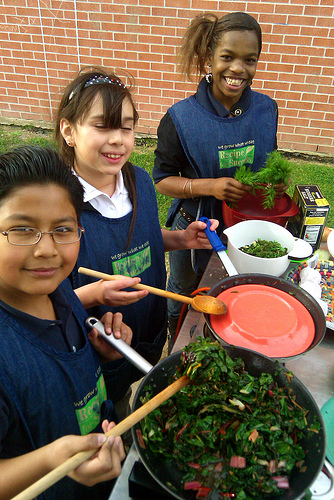 More fruits and vegetable consumption is exactly what Recipe for Success Foundation advocates. "Making healthy food fun" is the motto for RFS's award-winning Seed-to-Plate Nutrition Education program, offering interactive gardening and cooking classes. However we choose to empower our children to make healthier decisions - whether it's through a cooking class at school or through a commercial break on a prime time children's television show- we extend knowledge and power to a young generation who depend on our guidance to help mold their healthy habits.
More fruits and vegetable consumption is exactly what Recipe for Success Foundation advocates. "Making healthy food fun" is the motto for RFS's award-winning Seed-to-Plate Nutrition Education program, offering interactive gardening and cooking classes. However we choose to empower our children to make healthier decisions - whether it's through a cooking class at school or through a commercial break on a prime time children's television show- we extend knowledge and power to a young generation who depend on our guidance to help mold their healthy habits.Do you think that the new Disney marketing guidelines will affect what children crave for breakfast, lunch and dinner?
Balancing tight budgets, complex nutrition regulation and strict food safety requirements, cafeteria workers Tray Talk Blog do their best to serve the hundreds of students they see each day a meal that will feed the stomach and the mind. Just as lunchtime is at the center of each school, healthy eating is at the center of an alert and functioning mind.
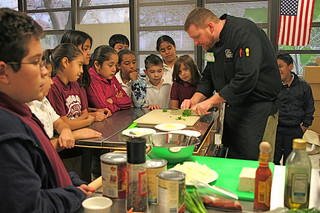 As we raise our forks in support of school nutrition employees, we need to remember that cafeteria workers - although they are the first to come to mind - are not the only school professionals that influence our children's eating habits. The shift towards healthier eating in the lunchroom is part of the overall shift towards a healthier lifestyle.
As we raise our forks in support of school nutrition employees, we need to remember that cafeteria workers - although they are the first to come to mind - are not the only school professionals that influence our children's eating habits. The shift towards healthier eating in the lunchroom is part of the overall shift towards a healthier lifestyle.Recipe for Success Foundation's (RFS) award winning Seed-to-Plate Nutrition EducationÔ (S2P) program offers a fully integrated cooking and gardening program that complements the students' core curriculum learning objectives. This S2P program provides students with the tools they need to make positive eating choices once they leave their cooking or gardening class; these choices are put to the test in the lunchroom and at home, putting their S2P knowledge to use as they make dietary decisions.
Now is the time for all school nutrition employees, no matter how directly or indirectly they are involved in the students' food education, to join forces and work in tandem towards the unifying goal of healthier students.
For some ideas of how you can celebrate School Nutrition Employee Week, check this out: School Nutrition
Do you have any creative ways to honor your favorite school nutrition employee?
 There was much hootin, hollerin, and high-fivin when the President signed the bill into law last December. But let's not get ahead of ourselves. The devil is in the details.
There was much hootin, hollerin, and high-fivin when the President signed the bill into law last December. But let's not get ahead of ourselves. The devil is in the details.The new law increases funding for school lunch by 6 cents a meal; supports and promotes school gardens and farm to school purchasing arrangements; and it expands eligibility for free lunch to more low-income kids. Most celebrated by activists was the shift from nutrition-based standards to food-based standards, which will help do away with much of the processed food masquerading as healthy because it has chemical additives for vitamins and minerals. This shift means that a sugar-steeped pop tart will no longer count as a serving of fruit and multi grain bread.
The other hammer handed to nutrition advocates is that these new rules will apply to all food available at any time on campus, including in vending machines or a la carte items offered for sale. Bottom line is that kids need to eat more freshly prepared or raw fruits and vegetables, and less salt, sugar and saturated fat found in their current diet of predominantly processed food. The USDA guidelines gave parents and nutrition advocates the tools to achieve needed changes.
Unfortunately, this bill could now go the way of many unfunded mandates before it--cut off at the knees by lack of money for implementation, monitoring or oversight. And we are in jeopardy of losing much of its potential power when rules are finalized in December 2013. Lobbyists are hard at work wearing down members of Congress, demanding change. The dairy lobby scored a major early victory with flavored milk appearing on the allowed list, even though it contains as much sugar by volume as a full-octane soft drink. They won by arguing, "Otherwise children wouldn't drink enough milk to get their needed minimum calcium." Now other food lobbyists are clamoring "me too" claiming important health benefits that fly in the face of all the science.
With balanced budget arguments ruling the Hill, the Congressional appropriations committee is taking another look at the whopping 6 cent per lunch reimbursement increase and the money to help schools refit their cafeteria kitchens, so that they can cook again. There is a rider to the agricultural spending bill circulating now that basically axes all the funding for proposals to improve nutritional quality of our kids school lunch.
For those who argue that the government should stay out of school lunch anyway, I would like to point out that it would never exist without Uncle Sam. Started in 1946 in response to the nutritional deficiencies of U.S. military recruits who were unfit to fight because they were starving to death, the post-war school lunch program soon became embroiled in serial struggles among food and drink companies, farmers, agribusiness, school administrators, and nutritionists over who could regulate what, where, and when. After-all, feeding 50 million school kids, 5 days a week, 9 months a year, is very, very big business.
In 1983, acting on a suit brought by the National Soft Drink Association, a panel of judges ruled that the USDA could regulate drinks only in public-school cafeterias, and only at mealtimes. As long as soft-drink and candy companies had the permission of local school boards and administrators, they could sell anything anytime or anyplace else. And of course local boards and administrators were vulnerable to the money waved around by food companies anxious to have access to all those young consumers. Funds for scoreboards and art programs assuaged any guilt. That kicked open the door to unprecedented promotion of junk food to kids who are especially vulnerable to sophisticated marketing techniques and away from their parents' rules. Pretty soon the junk bled out of the vending machines and into cafeterias as districts looked for ways to cut costs. Cafeteria kitchens slowly disappeared and fresh cooked lunches at school went the way of the dinosaur as big food got into the school lunch business with cut-heat-and-serve processed meals and promoted their fast food products to our kids. In the meantime, our kids got fatter, suffered from ADD/AHD and their health and grades spiraled down in a double helix. Two things are happening when we present poor quality food to our kids at school: We are teaching them that junk food is OK to eat--a perception that will be nearly impossible to erase as they mature; and we are slowly killing them.
Circling back around to the genesis of school lunch, the US Military now complains that recruits are so overweight that it's a threat to national security because they have to decline the 21% of available recruits who are too obese to fight.
So, our health, our future productivity, the viability of our health care system and even our national security is at stake. Reach out to your representative today. Tell him/her that we are paying attention. The nutritional quality of school lunch is too important to be sold to the highest bidder. Keep your hands off the Healthy, Hunger-Free Kids Act of 2010 and the USDA's proposed rules to support it.
We can no longer sit by and watch our children's health go down the drain for want of effective nutritional guidelines and quality execution of the school lunch program. Let the power of the marketplace speak for itself. I am calling on all parents to send a strong message to administrators and lawmakers by using the National School Lunch Week to boycott school lunches.
Childhood obesity is on the rise, lunch is an important part of a child's daily nutrition, and National School Lunch Week is October 11-15, yet First Lady Michelle Obama's child nutrition bill has stalled in Congress leaving school lunches underfunded and missing the mark on good nourishment. We have every right to expect the providers of our children's school lunches to strive for health, but most fall dreadfully short. What we get are dismal, monochrome servings of salty, high-fat, processed food, without an appealing fresh fruit or vegetable in sight. On top of that, our kids have to run the gamut through an overwhelming array of sweets and junk food that line the checkout isle. Citing funding issues and cost cutting measures, districts poor mouth us and point every way but to themselves. In the meantime, companies like Revolution Foods are proving that delivering a high quality handmade school lunch with zero processed food is well within the economic reach of most.
Until school lunches get healthier and competing a-la-carte and vending machine junk foods are removed from the school cafeteria, I am urging parents to send a healthy lunch from home.
The RFS culinary team has provided suggestions for a week's worth of healthy, fun and fresh
lunches as part of the launch of our "Talking Seed-to-Plate" blog. These options are affordable, colorful and tasty enough to tempt even the most finicky child.
Please join in the conversation and share your own tips and frustrations at https://www.recipe4success.org/seedtoplate/, where our team of professional chefs and educators will answer questions, and continue to post new menus and ideas for or engaging children in their own well being through activities in the kitchen and garden.
And plan to attend "Lunch Line" a documentary presented by our friends at www.thelunchtray.com in conjunction with Applegate Farms.
We must get control of this situation and save our children's lives. NOW.
Chef Kass had heard good things about Recipe for Success and our Chefs in Schools™ program. He especially like the way we make it easy for busy professional chefs to just drop into class for an hour, have big impact on kids and get back to work quickly. Our framework of support takes the burden out of volunteering for 60 of Houston's best chefs and our Seed-to-Plate Nutrition Education Program™ for elementary students is delivering impressive results.
"When are you going to national scale?" was the question I had been fielding all week in meeting after meeting with federal agencies from Department of Education to Department of Agriculture. And now Chef Kass was asking me, "If I do some sort of event with chefs in May, will you have your national program ready?"
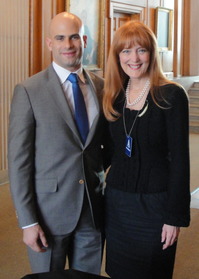 "No. But, we can have it for them by the time school starts in the fall," I assured. Then I raced home to put our National Affiliate program development into fast forward.
It seemed like just a few days after, but it was three months later when Sam and I started playing telephone tag in late-May. We finally connected, as he was climbing on a plane to Chicago for Memorial weekend with the First Family. "Gracie, come to the White House and bring all your chefs! I'll email you the security forms right now and I need them back by Monday morning."
His call to action--Chefs Move! To Schools would be on June 4. His goal: to fill the South Lawn with white jackets, get the attention of national press, and whip up some excitement. Imagine the sight! June 4th--my 58th birthday.
"No. But, we can have it for them by the time school starts in the fall," I assured. Then I raced home to put our National Affiliate program development into fast forward.
It seemed like just a few days after, but it was three months later when Sam and I started playing telephone tag in late-May. We finally connected, as he was climbing on a plane to Chicago for Memorial weekend with the First Family. "Gracie, come to the White House and bring all your chefs! I'll email you the security forms right now and I need them back by Monday morning."
His call to action--Chefs Move! To Schools would be on June 4. His goal: to fill the South Lawn with white jackets, get the attention of national press, and whip up some excitement. Imagine the sight! June 4th--my 58th birthday. Was the timing inconvenient? Yes. Was it going to be expensive? Yes. Was it going to be tough to round up enough folks to participate on such short notice? Yes. Did I have the time to drop everything and get this organized? No. Was I going to miss it? Not on your life.
I have been working on childhood obesity since the mid-nineties, establishing Recipe for Success Foundation in 2005 to launch a school based nutrition education program designed around the volunteer engagement of professional chefs. Our Seed-to-Plate Nutrition Education™ is now the largest program of its kind in the country--we teach 3050 children each month; and I spend all my time trying to shed light and public awareness on this stealth killer. Having the First Lady of the United States espouse a national call to action that sounds like it was written from the RFS playbook is like experiencing a lifetime of birthday celebrations rolled into one and handed up on a silver platter.
It took me about 10 minutes to rip out an email to my 24 board members and 60 Chefs Advisory Board members. Only minutes passed before answers started coming back: Board members Bob Cavnar, Steph Walker and Rick Terry, the first to say yes; then chefs Monica Pope (t'afia) who would bring daughter Lili; Randy Evans (Haven); Michael Kramer (Voice) and Barbara McKnight (Catering by Culinaire) in short order. In an extraordinary act of generosity, Beth Madison decided to postpone her long-planned June 3rd Gala in Small Bites dinner, so that Chef Peter Garcia (El Meson) could join the group. Then the news that Kiran Verma (Kiran's) would be with us, along with board members Melanie Wilson Lawson and Lucia Hamilton. Before the sun set, we had our merry band of thirteen ready to roll.
June 4, 7:30 a.m. What a spectacle we are--resplendent as we stroll down Pennsylvania Avenue in our Recipe for Success branded aprons and chef jackets, on our way to a breakfast hosted by Share Our Strength
 . Monica, swarmed by the Bravo TV crowd as she enters the room, is our megawatt star. But not the only one who is recognized. Everyone is hailing colleagues from all around the country and the air is thick with excitement and celebrity spotting. Here is Marcus Samuelsson, there Art Smith, over there, Daniel Boulud and Tom Colicchio.
Is that Rachel Ray talking to Cat Cora?? Food Network stars are here in force and huge groups of chefs from IACP, Les Dames Escoffier and other clubs, circulating like large schools of fish. US Secretary of Education, Arne Duncan addresses the group about how important good nutrition is for learning. Author Janet Poppendieck talks about the problem with school lunch. Chefs are fired up to help and looking for a way to plug in.
. Monica, swarmed by the Bravo TV crowd as she enters the room, is our megawatt star. But not the only one who is recognized. Everyone is hailing colleagues from all around the country and the air is thick with excitement and celebrity spotting. Here is Marcus Samuelsson, there Art Smith, over there, Daniel Boulud and Tom Colicchio.
Is that Rachel Ray talking to Cat Cora?? Food Network stars are here in force and huge groups of chefs from IACP, Les Dames Escoffier and other clubs, circulating like large schools of fish. US Secretary of Education, Arne Duncan addresses the group about how important good nutrition is for learning. Author Janet Poppendieck talks about the problem with school lunch. Chefs are fired up to help and looking for a way to plug in.Recipe for Success is definitely the little engine that could. We are featured in the program on a short list of recommended resource for interested chefs alongside such national heavyweights as Share our Strength, Center for Ecoliteracy, Center for Science in the Public Interest, The Lunch Box, and the First Lady's own Let's Move! website. Our team takes it a step further--our pockets full of RFS information cards that we hand out like candy.
White House security gate opens at 10:30 and we are thinking it would be good to be there early and first in line, so we duck out of the breakfast and scoot across the street. It is already 90 degrees as we cluster outside the gate under a nice shade tree and "glow." Five minutes later, the line stretches 500 hundred chefs around the block.
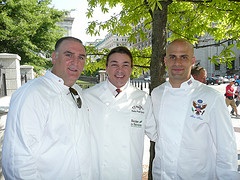
Chit chat, take pictures, Sam comes out and talks to us. It becomes a game, people coming up to Monica . . ."I know you, weren't we at the xyz Food Festival together?" No. "Didn't we meet at this that or the other place?" No. "Wasn't it . . .?" Well, maybe you saw me on Top Chef. "Can I get a picture with you?"
There is a buzz about Recipe for Success. "These guys make it easy for us to help," brags Randy Evans to a group as he hands out our cards. Many had heard about us, saw us in the program, or read about us on the Obama Foodarama blog.
 I feel like The Godfather; chefs are pressing their cards into my hand. "Call me when you are ready for LA . . . .Are you coming to New York? . . . .I'm in Oregon . . . We need this in Miami . . . .Las Vegas is ready to roll, we would like to roll with you." We are hot in more ways than one.
I feel like The Godfather; chefs are pressing their cards into my hand. "Call me when you are ready for LA . . . .Are you coming to New York? . . . .I'm in Oregon . . . We need this in Miami . . . .Las Vegas is ready to roll, we would like to roll with you." We are hot in more ways than one.
Finally, security ushers us through the gates and into the famous White House Kitchen Garden. Everyone mugs among the eggplant and squash takes photos of each other and swelters, waiting until the last moment to peel away from the shade and breezes and take a seat in the blazing sun.



Our posse snares row two. Apparently you have to have a TV show to score the first row. We'll have to work on that one. I am right behind Al Smith and we visit about meeting when he was in Houston to speak at the Jr Forum Dinner. We fan ourselves with programs, with promo cards, with the souvenir paper chef toques. We peel off our aprons and hold them overhead for shade. We make relay runs for water and ice so that no one grabs our primo seats. And then like a cool gush of fresh air, Michelle Obama walks out and takes the stage. She is gorgeous and miraculously cool as a cucumber. Everyone marvels. She never breaks a sweat.
Mrs. Obama lets everyone else talk first and we politely listen, but it is the First Lady we want to hear and she doesn't let us down.
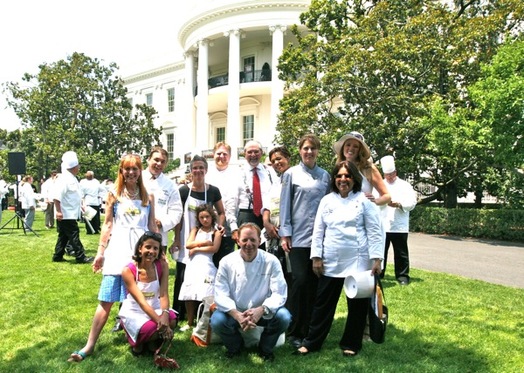
By GRACIE CAVNAR
HOUSTON CHRONICLE
Feb. 20, 2010, 7:37PM
First lady Michelle Obama recently announced her sweeping national initiative to combat childhood obesity. For the first time since this epidemic emerged, a comprehensive federal effort will coordinate with nonprofit organizations and the private sector to address the broad spectrum of contributing factors to obesity that together threaten generations of Americans with chronic disease and early death.
It's not a moment too soon. Already Texans are among the hardest hit by this phenomenon: In 2007, 66 percent of our adults and 32 percent of our high school students were clinically obese or severely overweight and at risk, and it's costing us a fortune. Obese children have a much higher risk of type 2 diabetes, hypertension, heart disease, liver disease, kidney failure and cancer. These diseases will strike them early, keep them out of the workplace and kill them young. Unhealthy eating is also taking a huge scholastic toll. Studies link diets high in refined sugar and saturated and trans fats to poor academics as nutrient-starved brains fail to operate effectively. The cause of this alarming spike in obesity is a complex web of changes that have taken place in our culture over the past 20 years.
Thanks to an early start on the front lines, Houston is now in an excellent position to emerge as a national leader and role model in the battle of the bulge. After an extensive study on obesity in 2003, St. Luke's Episcopal Health Charities concluded that an effective solution requires a multipronged approach of reforms at every government level along with the support of our entire community. We swung into action. In 2005, Texas was among the first states to ban vending machines from elementary schools. The mayor established the Houston Wellness Association in 2006 to advance community health. City Hall also paved the way for fresh-food production, farmers markets and grocery stores in neighborhoods that lack critical access, and improved parks, streetlights and sidewalks so children could walk to school and play outside. Recent completion of upgrades to their food-service facility has enabled Aramark/HISD to affordably meet new nutritional guidelines for school lunches. The Healthy Kids, Healthy Schools initiative mobilized parents and teachers to get involved in establishing healthier environments across multiple school districts. Partnerships like CAN DO (Children And Neighbors Defeat Obesity) facilitate far-reaching cooperation to change habits in neighborhoods using multiple entities to weave exercise and nutrition education opportunities together with enhanced food availability.
Many Houston programs serve as national models for transformation, but there is still much to do before we solve this problem once and for all. Recipe for Success Foundation, or RFS -- by working with the city, Houston ISD, every willing collaborator and 58 of our town's finest chefs -- has grown into the largest nutrition education initiative of its kind in the country. Reaching 3,000 Houston children every month and planning national expansion to meet increased demands, the successful RFS Seed-to-Plate Nutrition Education program gives children hands-on learning opportunities that empower them to create their own healthy meals and snacks. It is critical to educate a new kind of food consumer who integrates a nutritious diet into his or her normal lifestyle, rather than isolating the concept of healthy eating as an anomaly relegated to weight loss activity. RFS focuses on elementary students -- increasing their consumption of fresh fruits and vegetables and lowering their resistance to trying new foods -- because research says weight patterns and food attitudes are set for life by age 11. Their experiential classes in school gardens and kitchen classrooms are making a marked difference, with parents reporting that their kids are now cooking at home and turning away from foods they have learned are unhealthy.
Still, it's parents who have the most influence over a child's food attitudes, diet and healthy habits. It's an uphill battle in a perfect storm that makes the job harder than ever: Less unstructured playtime for the kids; a more sedentary lifestyle for all of us; billions of dollars of advertising directed at impressionable young people to promote junk food of every stripe; and a swirling family and work schedule that gets in the way of eating meals together.
Americans make as many as 4,000 eating decisions every single year of their lives, so there are many opportunities for modification. As consumers, we have extraordinary power and we must seize it. Will you join the fight?
Be proactive
• • Don't assume that food products available for sale are automatically safe for you and your family to eat. Ask questions.
• • Read food labels and understand what they mean so you can make better decisions.
• • Learn what age-appropriate nutrition your child needs for healthy body and brain development.
• • Get involved at school: Stop by for lunch; insist that your school offer appealing, healthy choices that don't have to compete with unhealthy a la carte items; if you are unhappy with the menus, send a healthy lunch from home; make sure vending machines have disappeared from your school and that clubs don't raise funds with candy and junk food.
Be a good role model
These are small steps that you can take to slowly change your home environment.
• • Provide only healthy choices at home. Research shows that children eat what's there, whether it's an apple or a bag of chips.
• • Don't give up on introducing healthy foods. It takes up to 15 offers before a child will accept something new.
• • Limit sodas and sugary drinks -- even too much fruit juice is not good -- and promote the consumption of water. Our kids drink about five sodas every day. That's 7,000 empty calories and two extra pounds a week.
• • Introduce your children to fresh whole foods by including them in shopping, gardening and cooking. Children willingly eat new healthy foods that they have helped grow, plan or prepare.
• • Train by example: Model and teach healthy food choices, frequency and portion sizes. Portion size directly affects how much we eat. Don't supersize! A healthy serving is the size of a pack of cards. Eat together at home more often.
• • Exercise as a family -- walking, swimming, biking, dancing, games -- and get the kids involved in team sports.
• • Limit TV viewing and recreational screen time to less than two hours daily.
Raise an aware consumer
Children are very susceptible to slick marketing campaigns but can't yet make an informed decision about what is true and what isn't.
• • Educate your children about the difference between advertising promotions and facts.
• • Tutor your family to read nutrition labels and understand what they mean.
• • Set limits for your kids. Treats in moderation are OK, just not instead of healthy meals.
Be the change
Don't think you have to do everything at once. Small changes over time will make a big difference in your life and that of the next generation. Now, turn off the TV, cook dinner with your kids, and then take the family for a walk. Come on, Houston! Let's show the rest of the country how it's done.
Cavnar is founder of the Recipe for Success Foundation.
http://www.chron.com/disp/story.mpl/editorial/outlook/6877416.html
HISD waited until the very last minute to get their new federally-mandated Wellness Policy in place before the start of the 2006-07 school year. We havent seen the ultimately approved document yet, but we do know that there were last minute changes made to the final draft attached below.
Even the draft falls prey to shortcomings pointed out by Action for Healthy Kids' review of a sampling from across the country. HISD's goals are general, without either measurable guidelines or penalties for lack of compliance. As always, the ultimate responsibility for vigilence lies with parents and the community and depends entirely upon the willingness of an individual school's administration.
RFS calls for the HISD School Board to not settle on this new Wellness Policy as final document, rather a work in progress that can be continually improved.





